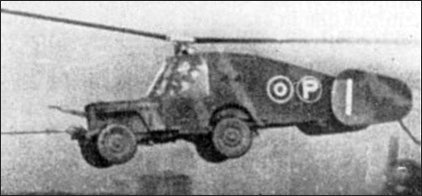
| Hafner "Rotabuggy" 1932 |  |
 |

| Hafner "Rotabuggy" 1932 |  |
 |
|
Designed by Austrian Raoul Hafner of the British Airborne Forces Experimental Establishment, the Rotabuggy was essentially a jeep converted into an autogiro as a way of giving airborne forces some ground ttansport. Initial flight trials, with the Rotabuggy towed behind a Whitley bomber, proved exhausting to the pilot who had to hang on to the control column which thrashed continuously around the cockpit. On flights where the tow cable remained attached there were some scary moments as the Rotabuggy, on the edge of a stall, touched down after the tow plane left and the driver took over. Development of vehicle-carrying gliders provided a safer and more efficient way of getting jeeps with more equipment (such as towed light guns) to the battlefield and the Rotabuggy never saw service. Another of Hafner's ideas was the Rotatank, a modified Valentine tank, which fortunately never left the drawing board. Jim Winchester "The World's Worst Aircraft", 2005
The rotorcraft team of the Airborne Forces Experimental Establishment (AFEE), handed by Raoul Hafner, had enjoyed some success in developing the so-called Rotachute (the idea of using a rotor rather than a parachute as a means of pinpoint landing troops in enemy territory), and this led to the suggestion that the principle could be applied to larger loads. This prompted Hafner to propose the Rotabuggy, a rotor-equipped Jeep, and the Rotatank, a similarly-equipped Valentine tank. A contract to develop the former was placed with the ML Aviation Company at WHite Waltham in 1942, this being covered by specification 10/42. The first trials connected with the development of the Rotabuggy consisted of loading a Jeep or, more formally, a Willys Truck 4x4 model MB, with concrete and dropping it from heights up to 2.35m to ascertain the amount of g that could be absorbed without incurring damage. It was found that 11g could safely be accepted, and a two-bladed rotor with a dimeter of 12.40m was the fitted, and a streamlined tail fairing, tailplane and twin fins (no rudders) were applied, together with a "hanging" control column, a rotor tachometer and glider navigational instruments. The Rotabuggy was first towed along the runway at high speed behind a 4.5l supercharged Bentley, eventually attaining towed airborne speeds up to 105kph IAS, the Rotabuggy becoming airborne for the first time on 16 November 1943. These trials took place at Sherburn-in-Elmet, near Leeds, where, eventually, the Rotabuggy was towed into the air behind a Whitley. The initial test behind the Whitley allegedly left much to be desired, the "hanging" control column threshing about and the "pilot" having to exert all his strength to maintain control. The initial problems were progressively ironed out, and the general handling and flying qualities of the Rotabuggy were eventually described officially as "highly satisfactory", but the availability of vechicle-carrying gliders rendered further development unnecessary. The Rotabuggy had a gross weight of 1411kg of which 964kg was the empty weight of the Jeep and 249kg the weight of the rotor unit and tail. The design max speed was 241kph, and estimated rates of descent ranged from 4.9m/s to 10m/s. The minimum take-off and landing speed was 58kph, and basic and max sea level rotor speeds were 230 and 260rpm.
- The Rotabuggy was fitted with a streamlined tail fairing with twin rudderless fins. Later, larger area fins were fitted, but still had to be a horizontal shape to ensure clearance of the rotors. - Additional equipment included a rotor tachometer and some basic flight instruments taken from a glider. - The strength of the basic jeep was tested by filling it with concrete and dropping it from a height, proving that it could widistand impacts of 11g. - The Rotabuggy was crewed by two men, one of whom drove using the regular controls and the other who controlled the rotor using a column which hung down from the cabin roof.
|